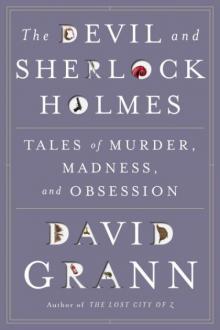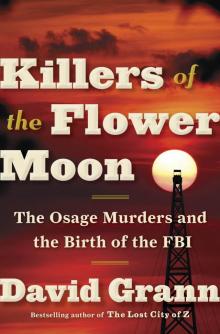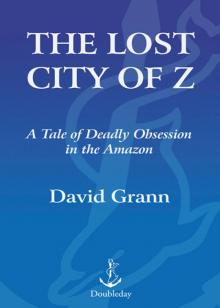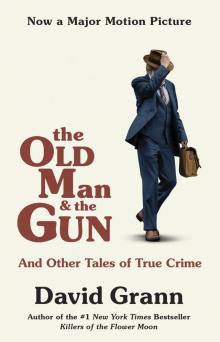- Home
- David Grann
Killers of the Flower Moon Page 11
Killers of the Flower Moon Read online
Page 11
Morrison, whom Agent Burger described as an “unusually shrewd and reckless and self-confessed criminal,” dressed like a dance-hall hustler. Tall, bullet scarred, small-eyed, and jittery, he seemed to be wasting away from within—hence his nickname, Slim. “Talks and smokes cigarettes a lot,” Agent Burger noted in a report. “Sniffs nose and works mouth and nose like rabbit almost continuously, especially when excited.”
The feds cut a deal with Morrison: in return for getting his arrest warrant for assault quashed, he would work as an informant on the Osage murder cases. Agent Burger told headquarters, “This arrangement is strictly confidential and not to be divulged outside of this Bureau to anyone, under any circumstances.”
There was a risk that Morrison might slip away, and before releasing him, Agent Burger made sure that he’d gone through a rigorous process known as Bertillonage. Devised by the French criminologist Alphonse Bertillon in 1879, it was the first scientific method for identifying repeat criminals. Using a caliper and other special tools, Agent Burger, with the help of the Dallas police, took eleven of Morrison’s body measurements. Among them were the length of his left foot, the width and length of his head, and the diameter of his right ear.
After Agent Burger informed Morrison of the purpose of these measurements, he also commissioned a mug shot, another of Bertillon’s innovations. In 1894, Ida Tarbell, the muckraking journalist, wrote that any prisoner who passed through Bertillon’s system would be forever “spotted”: “He may efface his tattooing, compress his chest, dye his hair, extract his teeth, scar his body, dissimulate his height. It is useless.”
But Bertillonage was already being displaced by a more efficient method of identification that was revolutionizing the world of scientific detection: fingerprinting. In some cases, a suspect could now be placed at the scene of a crime even without a witness present. When Hoover became the bureau’s acting director, he created the Identification Division, a central repository for the fingerprints of arrested criminals from around the country. Such scientific methods, Hoover proclaimed, would assist “the guardians of civilization in the face of the common danger.”
Agent Burger had Morrison’s fingertips dabbed in ink. “We have his picture, description, measurements and fingerprints in the event we have cause to apprehend him,” he informed headquarters.
He then gave Morrison some spending money. Morrison promised to visit Rose Osage and Joe Allen as well as members of the underworld, to see what he could learn about the murders. Morrison warned that if anyone discovered he was working for the feds, it would mean his death.
He reported back that he had asked Rose, regarding Anna’s murder, “Why’d you do it?” And she replied, “You don’t know a god damn thing about it, Slim, I did not kill Anna.” In a memo, Agent Burger noted of his prized informant, “If he is not bumped off too soon he can do us a lot of good.”
White now reviewed all the information that had been gathered by Morrison and the agents regarding Rose Osage and Joe Allen. In light of Rose’s statement to Morrison and the fact that the rooming house owner had confirmed Rose and Joe’s alibi, the Kaw Indian’s statement that Rose had confessed to her seemed puzzling. One detail, in particular, was curious. According to the Kaw Indian’s account of Rose’s confession, Anna was in the car when Rose shot her, and her body was then dumped at Three Mile Creek, where Rose also discarded her own bloodstained clothes.
The autopsy findings were telling. Criminologists had come to understand that blood coagulates at the lowest point of a body after death, producing dark splotches on the skin. If, when one finds a corpse, these splotches appear on the higher regions, it is a sign that someone has moved the body. In Anna’s case, the doctors had not reported any indications of this, and from all the descriptions of the crime scene there had been no trail of blood from the car down to the creek.
It seemed that the witness must be lying and that Rose and Joe were innocent. This would explain why the Dictograph set up by the private detectives working for Mollie Burkhart’s family had never picked up any incriminating statements, and why Rose’s clothes had never been found in the creek. When agents interrogated the Kaw Indian, it didn’t take much for her to crack. She admitted that Rose had never told her any such story about the killing. In fact, a strange white man had come to her house, written up the statement, and forced her to sign it, even though none of it was true. White realized that the conspirators were not only erasing evidence—they were manufacturing it.
11 THE THIRD MAN
Hoover immediately began pestering White for updates. Once, when White was in the field and did not respond immediately, Hoover chastised him, saying, “I do not understand why, at the end of the day, you could not have wired me fully as to the developments and general situation.” Hoover’s attention to the case had waxed and waned over the years, but he had become so agitated about the growing criticism he was receiving in Oklahoma that prior to White’s arrival he had started to investigate matters himself. Though he was not one to venture into the muck of the field (he had a phobia of germs and had installed in his home a special filtration system to purify the air), he would sit in his office, poring over incoming reports from agents—his eyes and ears on the menacing world.
As Hoover studied the reports on the Osage murders, he found it an “interesting observation” that Anna Brown and Roan were both killed with a bullet to the back of the head, and “after carefully going over all of the angles,” he came to believe that a white woman, Necia Kenny, who was married to an Osage man, might hold the key to the case. Kenny had told agents that A. W. Comstock, the attorney who served as a guardian for several Osage, was likely part of the conspiracy. Hoover hadn’t forgotten that Comstock had criticized the bureau and had threatened to turn Senator Curtis against him—which made Comstock, in Hoover’s eyes, a malicious rat. “I am convinced that Mrs. Kenny is pretty well on the right track,” Hoover had told one of his agents.
A. W. Comstock with an Osage Indian Credit 38
Kenny had a history of mental instability—she claimed to be possessed by spells—and she had once even attempted to murder another local attorney. Still, Hoover himself had interviewed her in Washington, not once, but twice, and he arranged for a government expert on “mental diseases” to evaluate her. The doctor concluded that she was paranoid, but noted, as Hoover put it, that she “perceives items which would escape the observation of the average individual.” As a result, Hoover said, Kenny “is of greater value to us in furnishing leads than she would be possibly as a witness.”
White hadn’t been able to substantiate Kenny’s allegations, but he wasn’t sure what to make of Comstock, either. Armed with his English Bulldog revolver, Comstock was one of the few prominent white citizens in Osage County who seemed willing to assist investigators. He had told agents that he was sure he could secure critical evidence—if only he could have access to the bureau’s files. White refused to share any confidential records. Still, Comstock would routinely come to see White, sharing helpful tidbits of information and checking on the progress of the investigation. Then he would disappear into the streets with his gleaming English Bulldog.
By the end of July 1925, White had turned his full attention to the last of the listed suspects in Anna Brown’s murder: Bryan Burkhart, Mollie’s brother-in-law. White learned that during the inquest, in 1921, Bryan had stated that on the night Anna disappeared he’d taken her straight home from Ernest and Mollie’s house, dropping her off between 4:30 and 5:00 p.m.; Bryan then headed into Fairfax, where he was seen with Hale, Ernest, and his visiting uncle and aunt, who went with him to watch the musical Bringing Up Father. There wouldn’t have been time for him to go to the creek, shoot Anna, and return to town before the show started. His alibi seemed airtight.
To corroborate it, Agent Burger and a colleague had earlier traveled to Campbell, a town in northern Texas, where Ernest and Bryan’s aunt and uncle lived. The agents sped past the old trails that cowboys had once
followed—trails that were now supplanted by cattle cars pulled by shrieking locomotives. Agents discovered that Hale had grown up in a wooded grove only a few miles from Campbell. His mother had died when he was three years old—the King of the Osage Hills, too, burdened by a past.
In Campbell, agents stopped at the austere house of Bryan’s uncle and aunt. The uncle was away, but the aunt invited the investigators inside and launched into a venomous rant about how Ernest had married one of those red millionaires. Burger asked her about the night Anna disappeared. Oh, she’d heard the whispers about how Bryan was responsible for killing that drunken Indian, she said. But none of it was true. After dropping Anna off, Bryan had joined the rest of the party in Fairfax.
The uncle suddenly appeared at the front door. He seemed displeased to find a pair of federal agents inside his home. He was reluctant to speak, but he confirmed that Bryan had met them in Fairfax after dropping Anna off. He added that after the show he and his wife had spent the evening in the same house with Bryan and that Bryan was there the whole time; he simply couldn’t have been the murderer. The uncle then made it clear that he wanted the agents to get the hell out.
In August 1925, White sent his undercover operatives to infiltrate the town of Ralston. White wanted his team to investigate a lead that had not been properly followed up: on the night Anna Brown disappeared, case records showed, she might have been spotted in a car by a group of white men who were sitting in front of a hotel on Ralston’s main street. Previous investigators, including local lawmen and the private eyes, had spoken to these valuable witnesses and then seemingly buried what they had learned. At least one of the witnesses had since vanished, and White was convinced that, as one agent had noted in a report, such people were being “paid by suspects to go away and stay away.”
White and his men tried to track down some of the witnesses outside the hotel, including an elderly farmer who had been questioned earlier by an agent. During that initial interview, the farmer had seemed to be suffering from dementia: he had stared at the agent blankly. After a while, though, he had perked up. His memory was just fine, he explained; he’d simply wanted to make sure that the investigators were who they said they were. Talking to the wrong person about these murders was liable to get one planted in the ground.
The farmer now spoke to White and his men. According to testimony that the farmer subsequently gave under oath, he remembered that evening well, because he’d often discussed it with friends of his who gathered regularly at the hotel. “We old fellows have a lot of time in town and that is where we sit down,” he said. He recalled that the car had stopped by the curb and through its open window he could see Anna—she was right there in front of him. She said hello, and someone in the group said back, “Hello, Annie.”
The farmer’s wife, who had been with him in Ralston that night, was also certain that the woman in the car was Anna, though she didn’t talk to her. “There was Indians so much around there,” she testified. “Sometimes I spoke to one, and sometimes I didn’t. Sometimes when I spoke to one they didn’t speak.” Asked if Anna had been slumped over from drinking, she said, “Just sitting like they all sit, just about like this.” She posed herself straight and rigid, like a statue, her rendition of a stoic Indian.
At one point, she was asked if anyone had been with Anna in the car.
“Yes, sir,” the farmer’s wife said.
“Who?”
“Bryan Burkhart.”
Bryan, she said, had been driving the car and wearing a cowboy hat. Another witness said that he also saw Bryan with Anna in the car. “They went straight west from there right on through town and I don’t know where they went from there,” the witness recalled.
It was the first proven crack in Bryan’s alibi. He might have taken Anna home, but he’d eventually gone back out with her. As an agent wrote in a report, Bryan “perjured himself when he swore before the coroner’s inquest at Fairfax…that he had left Anna safely at her home in Fairfax between 4:30 and 5 p.m.”
White needed to establish where the two had gone after leaving Ralston. Piecing together details from Agent Burger’s previous informants as well as from witnesses located by the undercover team, White was able to create a time line. Bryan and Anna had stopped at a nearby speakeasy and stayed there until about 10:00 p.m. Then they headed to another hell joint, several miles north of Fairfax. Bryan’s uncle was spotted with them, so perhaps the uncle had been lying to Agent Burger, to cover not only for Bryan but for himself as well. The owner of the place told agents that Bryan and Anna had been drinking there until about 1:00 a.m.
Accounts of where Bryan and Anna went after that grew murkier. One witness said that they’d stopped, alone, at another speakeasy closer to Fairfax. Others reported seeing Bryan and Anna leave the speakeasy in the company of a “third man” who wasn’t the uncle. “Third man is said to have been present with Anna Brown and Bryan Burkhart,” Agent Burger noted. The last sighting of Anna and Bryan together that the investigators heard about had been at approximately 3:00 a.m. A witness who knew them both said that she’d heard a car stop near her house in Fairfax. A man whom she believed to be Bryan shouted, “Stop your foolishness, Annie, and get into this car.”
Bryan Burkhart Credit 39
After that, there was no trace of Anna—she’d been ghosted. Bryan’s neighbor, though, spotted him returning home at sunrise. Bryan later told the neighbor not to say a word to anybody, and gave him money to keep quiet.
White had homed in on a prime suspect. But, as with many mysteries, each answer to a question opened up another question. If Bryan had killed Anna, what was his motive? Was he involved in the other murders? And who was the third man?
12 A WILDERNESS OF MIRRORS
By the end of that summer, White began to suspect that there was a mole inside the investigation. When one of his agents was questioning a seedy local attorney—who, according to an informant, was trying to “strangle” the government’s probe—the attorney betrayed a shocking knowledge of the inner workings of the case. Finally, he admitted that he’d “seen part of the reports made by the Bureau…and had an opportunity to see more of them.”
The bureau’s probe had long been plagued by leaks and sabotage. One agent complained that “information contained in reports immediately gets into the possession of unauthorized and unscrupulous persons.” A U.S. attorney also discovered that the reports furnished to him by the bureau had vanished from his office. The breaches threatened the lives of agents and created insidious doubts, with officials questioning each other’s loyalty. One federal prosecutor demanded that no copy of his report be “handed to any representative of the State of Oklahoma.”
Perhaps most damagingly, two private eyes, including one from the Burns agency, tried to expose the bureau’s main informant, Kelsie Morrison. These private eyes leaked to several local officials that Morrison was working with the bureau, then went so far as to detain him on a trumped-up robbery charge. Agent Burger said that the conduct of one of these private detectives was “reprehensible” and was “certainly hurting our investigation.” Obstruction, he noted, appeared to be these private detectives’ “sole object,” adding, “Someone must be paying them to do this.” An agent reported that Morrison, after being released from jail, seemed “frightened out of his wits.” During one of their meetings, Morrison beseeched agents to get the “son-of-bitches” who did the killings before they got him. Agent Burger warned Morrison, “Look out for double crossing and traps.”
At night, White sometimes met with his team in the countryside, the men huddling in the dark like fugitives. Agents in the past had sensed that they were being followed, and White gave his men advice in case their cover was blown: “Keep your balance, avoid any rough stuff if possible.” Making it clear that they should carry weapons, he added, “But if you have to fight to survive, do a good job.”
The former New Mexico sheriff who played the role of a cattleman on White’s team Credit 40
White found himself wandering through a wilderness of mirrors—his work more akin to espionage than to criminal investigation. There were moles and double agents and possibly triple agents. No one had aroused more suspicion than the private eye called Pike. A gentleman in Osage County had once approached Agent Burger and introduced himself as an intermediary, a go-between, for Pike. Agents were aware that Pike had been hired by William Hale back in 1921 to solve the Osage murders but had abandoned the case after failing to make any progress.
The intermediary, however, said that Pike had actually withheld a crucial piece of information that he had discovered during his investigation: he knew the identity of the third man who’d been spotted with Bryan and Anna around the time that she was killed. Agent Burger wrote that Pike apparently “has known and talked with this third man.” But the intermediary made it clear that Pike would share this information under one condition: that he be paid a king’s ransom. “It is quite apparent there is some crooked work afoot,” Agent Burger wrote in a report.
Agents demanded, through the intermediary, that Pike come forward. But again he didn’t comply, evidently determined to extort money and obstruct justice. Agents launched a manhunt for Pike, whose last known address was in Kansas City. “Pike will have to be located and apprehended,” Agent Burger wrote. “He changed his Kansas City address soon after it became known that we were working on him. We feel sure he has been paid to skip.”
Not long after, Pike was caught allegedly committing highway robbery in Tulsa. Out of angles to play, he gave up a name of a local gambler. Agents could confirm that the gambler had been at one of the speakeasies drinking with Bryan and Anna on the night of May 21. But further investigation proved that the gambler had gone home too early to be the third man.

 The Devil & Sherlock Holmes: Tales of Murder, Madness & Obsession
The Devil & Sherlock Holmes: Tales of Murder, Madness & Obsession Killers of the Flower Moon
Killers of the Flower Moon The Lost City of Z
The Lost City of Z The Old Man and the Gun
The Old Man and the Gun